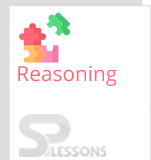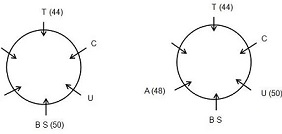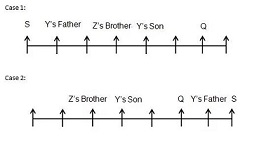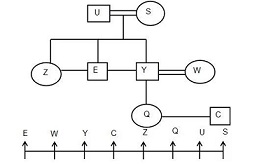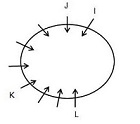 Introduction
Introduction
The questions on seating arrangement are regular feature of almost every competitive examination. In these questions, you have to arrange a group of persons fulfilling certain conditions. This is also written as sitting arrangement or sitting arrangement reasoning at some places.
Seating Arrangement is one of important topic in Reasoning Ability Section. In Seating Arrangement Practice Quiz 5 article candidates can find questions with answer. By solving this questions candidates can improve and maintain, speed, and accuracy in the exams. Seating Arrangement Practice Quiz 5 questions are very useful for different exams such as IBPS PO, Clerk, SSC CGL, SBI PO, NIACL Assistant, NICL AO, IBPS SO, RRB, Railways, LIC, Insurance, Civil Services etc.
 Quiz
Quiz
Directions(1 – 5): Read the following information carefully and answer the questions given below it:
Six players A,B,C,D,E and F of six different countries P,Q,R,S,T and U are sitting around circular table facing the center. they all scored different runs in the match viz:41 44 4850 52 and 54 but not necessarily in the same ordered.C The who scored second to the right of the
players of country S. The one who scored 54 runs is not C. The who scored 48 runs is seated second to the left of the player of country U. who is not A or C.B seated opposite of country T who scored 44 runs there is only one player between the players of county U and T he is not from of country P. players of country T sits second to the right of players of country U. The player who scored 50 runs is seated second to the right of A. The player who scored 52 runs is not seated near to the one who scored 44 runs.F is seated immediately left of the player of country R but near to A. The players of country P is not seated near to the player of country Q but immediate right of D.
1. Who is sitting opposite to the player of country Q?
- A. C
B. D
C. B
D. Player of country P
- A. Second to the right
B. Immediate right
C. Immediate left
D. Opposite
- A. E is the player of country U
B. C is second to the right of B but not near to E
C. B scored 52 runs and near to C
D. Player of country R is opposite to player of country S
- A. D
B. C
C. A
D. B
- A. Player of country R
B. The one who scored 41 runs
C. A
D. F
Directions(1 –5): Read the following information carefully and answer the questions given below it:
There are eight members Y, Z, U, W, Q,S,C and E. each of them is related to Y in some way or the other and all of them have different chocolates among 20, 27, 33, 38, 40,43,45 and 50 but not necessarily in the same order and all are sitting in a straight line facing North. Q is sitting second to right of Y's son. Two people are sitting between Q and Z's brother. Two people are sitting between Y's son and Y's father. S is an immediate neighbour of Y's father.S Iis sitting art one of extreme ends. The sum of chocolates. W and Y's brother sitting together. The difference between the chocolates of W and Z is equal to the different between the chocolates of Q and U. Y's bother is sitting second to left of Y. Two people are sitting between W and Y's sister. Y is not an immediate neighbour of Q. C has more number of chocolates than Y but less than S. E's father is sitting to the immediate right of Y's daughter.Y's wife is immediate neighbour of E. C is younger than U.
1. Who among the following sits third to the left of C?
- A. U
B. E
C. Z
D. Y
- A. Mother
B. Grandmother
C. Sister
D. Daughter
- A. 33
B. 20
C. 40
D. 38
- A. U
B. Z
C. W
D. E
- A. 88
B. 63
C. 70
D. 73
Directions(1 – 5): Read the following information carefully and answer the questions given below it:
Some persons are sitting around a circular table facing towards the centre of the table. The distance is equal among all the persons and number of persons was not more than 18 persons. The
Number of persons between Z and N when counted from left of Z was thrice as that of the number of persons seated between Z and L when counted from right of Z. L and N are neighbours of each other. I was seated to the immediate left of J and three persons are sitting between J and K. L was third to the right of K. M was second to the right of O and second to the left of I. L is to the immediate left of N.
1. How many persons are present in the above arrangement?
- A. Eleven
B. Fifteen
C. Seventeen
D. Thirteen
- A. Five
B. Seven
C. Six
D. Nine
- A. LO
B. ZK
C. JM
D. JO
- A. Second to the right
B. Third to the Right
C. Second to the left
D. Third to the left
- A. Seven
B. Five
C. Six
D. Four
Other Articles
 Study Guide
Study Guide
 Exams
Exams
| Competitive Exams - Entrance Exams | |||
|---|---|---|---|
| Category | Notification | ||
| UG | NSTSE 2020 | RIMC Admission 2020 | WBJEE EVETS 2019 |
| Diploma | HPBOSE D.El.Ed CET 2019 | Goa Diploma Admissions 2019 | |
PG |
GATE 2020 |
ATMA 2019 |
XAT 2020 |
| Click Here For – All India Entrance Exam Notifications | |||
 Daily CA
Daily CA
 Job-Alerts
Job-Alerts
 SP Quiz
SP Quiz
| Competitive Exams - Practice Sets | |
|---|---|
| Category | Quiz |
| English Language | Spotting Errors |
| Current Affairs | Current Affairs |
| Quantitative Aptitude | Compound Interest |
 GK
GK
| General Knowledge for Competitive Examinations | |
|---|---|
| Topic | Name of the Article |
| GK - World | Commonwealth Table Tennis Championships 2019 |
| Global Innovation Index 2019 | |
| GK - India | Sangeet Natak Akademi Awards 2019 |
| Socio – Religious Reform Movements | |
| GK - Abbreviations | International Organizations Abbreviations |
| Computer Abbreviations | |
| GK - Banking & Insurance | Banks and Headquarters |
| Non – Banking Financial Companies – India | |
| GK - Science & Technology | Botany Important Terms |
| Father of Different Fields – Science & Technology | |
